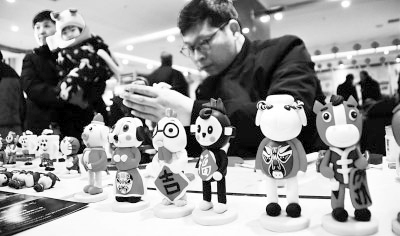Academics advocate balance of art, profit in cultural industry

A cultural gathering opens in Handan, Hebei Province on Jan. 3, with the theme “Embracing New Era and Enjoying New Life,” to bring cultural products and services to thousands of households. (GUANGMING DAILY)
People need to balance between aesthetic values and commercial interests in the cultural industry, said experts at the 15th Forum on International Cultural Industries hosted by Peking University earlier this month.
China is now witnessing an era in which the consumption of cultural products and quality goods prevails. However, such products are scarce in the cultural industry, said Lian Ji, president of the Chinese National Academy of Arts. Real economy is essential, said Lian, adding that the cultural industry, as a category of cultural economy, needs to follow the same rules of growth that apply to the real economy.
Hua Jian, director of the Cultural Industry Research Center at the Shanghai Academy of Social Sciences said that now China’s cultural industry is afflicted with overcapacity, insufficient consumption of cultural products and inadequate supply. Household expenditures on cultural products are still relatively low. At the same time, this indicates there is still enormous room for China’s cultural consumption to grow. Some surveys have shown that the entertainment and media industry has been most affected by the digital economy. Hua suggested encouraging consumption in this field based on a clear awareness of the contradictions and problems, and to realize its potential in the context of the digital economy.
In recent years, some academics have argued that TV’s days are numbered. Hu Zhifeng, dean of the School of Arts and Communication at Beijing Normal University, said this is an exaggeration. Hu said the new context of TV media should be interpreted based on three dimensions: globalization, media integration and national demand. TV media have been integrated into the giant framework of international capital. Chinese television is experiencing decreasing popularity, reduced revenues and brain drain. On the other hand, TV media still have the advantages of trustworthiness, accessibility and the potential to make high-quality products. For TV media to flourish in the future, it needs to reconsider its main producers, themes and marketing, Hu added.
Wang Yichuan, dean of the School of Arts at Peking University, said that the arts industry must carry forward the cultural missions in the new era, integrating aesthetic values, commercial interests and its political nature. A good piece of artwork is supposed to nurture people’s artistic tastes through experience and appreciation. Most importantly, as such experience and appreciation accumulate, people will be increasingly cultivated, Wang added.
Chen Xuguang, deputy dean of the School of Arts at Peking University, said the keywords for China’s film industry in 2017 include “enhanced quality,” “new norms” “industrial upgrading,” “industrial quality,” “new era of Chinese film” and “industrial aesthetics of film.” Technological indicators and high-concept film are merely indicators of industrial aesthetics. Although they are important, technologies are not almighty. China’s film industry has witnessed tremendous changes in film concepts, market size, industrial chain, technologies and marketing in the new era as well as the emergence of new directors. Following the rules of industrial aesthetics in one way or another, the new generation of directors has tried their best to seek balance between the artistic and economic value of a film, said Chen.

 PRINT
PRINT CLOSE
CLOSE